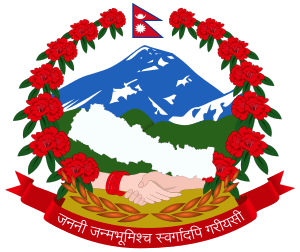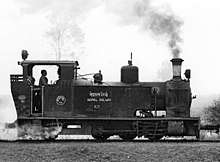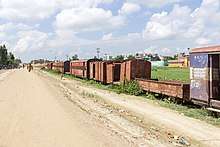Nepal Railways
 | |
| Nepal Railways | |
Native name | नेपाल रेल्वे |
| Government sector | |
| Industry | Rail transport |
| Fate | Acquired on 15 June 2011 |
| Predecessor | Nepal Government Railways |
| Successor | Nepal Railways Corporation Ltd |
| Founded | 1927 |
| Founder | Jang Bahadur Rana with association of British Indian Government |
| Defunct | 2014 |
| Headquarters | Bishalnagar, Kathmandu, Nepal |
Area served | Nepal |
Key people | Anant Acharya (Director General) |
| Owner | Nepal Government |
| Website |
www |
| Nepal Railways | |
|---|---|
 Janakpur station | |
| Overview | |
| System | Heavy rail |
| Termini |
Jainagar Janakpur |
| Operation | |
| Opened | First commercial service in 1927 |
| Technical | |
| Line length | 50 km (31 mi) |
| Track gauge | 1,676 mm (5 ft 6 in) |
Nepal Railways | |||||||||||||||||||||||||||||||||||||||||||||||||||||||||||||||||||||||||||||||||||||||||||||||||||||||||||||||||||||||||||||||||||||||||||||||||||||||||||||||||||||||||||||||||||||||
|---|---|---|---|---|---|---|---|---|---|---|---|---|---|---|---|---|---|---|---|---|---|---|---|---|---|---|---|---|---|---|---|---|---|---|---|---|---|---|---|---|---|---|---|---|---|---|---|---|---|---|---|---|---|---|---|---|---|---|---|---|---|---|---|---|---|---|---|---|---|---|---|---|---|---|---|---|---|---|---|---|---|---|---|---|---|---|---|---|---|---|---|---|---|---|---|---|---|---|---|---|---|---|---|---|---|---|---|---|---|---|---|---|---|---|---|---|---|---|---|---|---|---|---|---|---|---|---|---|---|---|---|---|---|---|---|---|---|---|---|---|---|---|---|---|---|---|---|---|---|---|---|---|---|---|---|---|---|---|---|---|---|---|---|---|---|---|---|---|---|---|---|---|---|---|---|---|---|---|---|---|---|---|---|
| |||||||||||||||||||||||||||||||||||||||||||||||||||||||||||||||||||||||||||||||||||||||||||||||||||||||||||||||||||||||||||||||||||||||||||||||||||||||||||||||||||||||||||||||||||||||
The Nepal Railways Corporation Ltd. (NRC, reporting mark: NR / ने. रे) is owned by the Nepalese Government, and is located in Nepal. The railway spreads into other neighboring territories.
It maintains and operates two railway lines: the Raxaul-Sirsiya and Jaynagar-Janakpur. The former is approximately a 6 km (3.7 mi) line from Raxaul, India to Sirsiya Inland Container Depot (or dry port) near Birganj, Nepal, and is primarily used for freight transport. The latter is a 53 km (33 mi) line from Jaynagar, India to Janakpur, Nepal, and is used primarily for passenger transport.
History

Introduced to Nepal during the Rana period, the Raxaul-Amlekhagunj section of the Nepal Government Railway (NGR) was built as a 2 ft 6 in (762 mm) narrow gauge railway. This 39-kilometre-long (24 mi) line built by the British in 1927, allowed people from different areas of the country to reach Amlekhganj, and helped move heavy vehicles to Bhimphedi. It was then possible to reach Kathmandu from Bhimphedi on foot, but the railway was later closed down. The historic Janakpur railway running between Nepal and India was once a major border crossing for citizens on both sides. The British built the 20-mile-long (32 km) track in 1937 to carry timber from the once heavily forested areas of Janakpur to the Indian city of Jainagar, but as supply dwindled, the train’s main cargo became people.
The Jayanagar-Janakpur Line (NJJR), a 2 ft 6 in (762 mm) narrow gauge railway, was also introduced during the Rana period. The Jayanagar-Janakpur-Bijalpura line is currently under gauge conversion to 1,676 mm (5 ft 6 in) with an extension to Bardibas.[1]
The 1,000 mm (3 ft 3 3⁄8 in) metre gauge railway track from Raxaul was converted to 1,676 mm (5 ft 6 in) by the Indian railways to connect Sirsiya (Birganj) Inland Container Depot (ICD). The railway became fully operational in 2005, though certain segments were used as early as 2002. It helps move containers and other cargo to and from the Kolkata port and other places in India. It is the most important entry point for imports into China, and is essential for Nepal's commerce and trade. Birganj is located 700 km (430 mi) from the Kolkata port by railway.

Until 2014, the Nepal Railway lines used 1,676 mm (5 ft 6 in) gauge lines.
In 2014, the Nepal Railway was shut down so that the Nepal Railway Corporation, with financial help from Indian Railways, could upgrade the track from its colonial days. The upgrade is an $11 billion endeavour. As construction faces numerous setbacks and deadlines go unmet, there are also accusations of contractors misusing materials meant for the line on other projects.[2] Over 130 railway employees who depended on the line’s continuous operation were laid off. The government widened this 59 km long railway track into broad gauge with the help of Indian railways. It is scheduled to open in October 2018.
Future
Nepal has an ambitious plan for the East-West Railway, including linking it to Kathmandu and the North-South Railway line, which includes the China–Nepal Railway and a link to the railway system of India via Raxaul.
The Lumbini-Hetauda-Janakpur section is thought to be the first East-West Railway line in Nepal. These two entry points will be valuable for tourists. Furthermore, they are among the most economical routes for trade with India and overseas.
The Birganj Dry Port was the first in Nepal to be connected by broad gauge link. Biratnagar may be the second such point and Mahendranagar may get a similar link.
Survey and plans
RITES, an engineering consultancy company founded by the Government of India, has conducted preliminary surveys for the following broad gauge lines:
- New Jalpaiguri (India) to Kakarbhitta (Nepal)
- Jogbani (India) to Biratnagar (Nepal)
- Nautanwa (India) to Bhairahawa (Nepal)
- Nepalganj Road (India) to Nepalganj (Nepal)
Railway stations
Safety
The Nepal Railways Corporation has a good safety record. In August 2012, a serious incident occurred when a locomotive ran away after the driver alighted for refreshment. The unmanned locomotive ran from Jaynagar to Janakpur at speeds far exceeding the restrictions on the line. At Janakpur, staff diverted the light engine onto a disused siding, on which they had placed heavy obstructions. The engine was halted and no-one was injured.[4]
See also
| Wikimedia Commons has media related to Nepal Railways. |
References
- ↑ http://www.farrail.net/pages/trip-reports-engl/nepal-2005-12.html
- ↑ "The Slow Revival of Nepal's Abandoned Railway to India". CityLab. Retrieved 2017-09-15.
- ↑ http://www.aa-net.ne.jp/y-asahi/JanakupurRailway/JR%20Route/JR%20Route.html
- ↑ Story reported here.